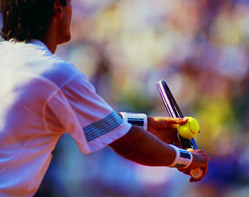Tennis elbow
 Tennis elbow or medically termed “lateral epicondylitis” is a painful inflammatory condition affecting the outer elbow. The name “tennis elbow” suggests that the condition is limited to tennis players only. Surprisingly this is untrue and is particularly common in labourers, squash players, computer operators etc. However, it has been found to affect approximately 1 in 20 tennis players.
Tennis elbow or medically termed “lateral epicondylitis” is a painful inflammatory condition affecting the outer elbow. The name “tennis elbow” suggests that the condition is limited to tennis players only. Surprisingly this is untrue and is particularly common in labourers, squash players, computer operators etc. However, it has been found to affect approximately 1 in 20 tennis players.
Pain occurs in the outer bony part of the of the elbow and may be exquisitely tender to touch. This pain may be referred down the back of the forearm into wrist and hand. The pain is usually made worse when gripping, turning a tap, opening a door, picking up objects, shaking hands and of course playing tennis, particularly backhand shots.
The disorder is usually an overuse injury which develops over time but may suddenly occur following an unaccustomed amount of wrist extension activity.
Pain occurs when excessive tension causes small tears to develop within either the extensor tendons or at the attachment of the wrist extensor muscles to the outer bony prominence of the elbow (lateral epicondyle). The pain experienced is due to inflammation at this point.
Causes
- Unaccustomed use
- Improper technique
- Unsuitable equipment eg: tennis racket too large or too heavy
- unsuitable workplace set up / inefficient use of mouse
- Lack of strength in the forearm muscles
- Lack of flexibility in the forearm muscles
- Weakness of proximal shoulder girdle musculature
- Referred pain either form the neck due to stiffness of neck joints (particularly on the same side) or from the nerve structures themselves
- Referred pain from the shoulder
- Peripheral nerve irritation or entrapment – particularly the radial nerve
Signs and symptoms
- Inability to lift an object with associated pain
- Pain when extending the wrist backwards and with gripping activities
- Point tenderness over the bony outer elbow and / or the distal muscles
- Pain on straightening the elbow
Prevention
- Stretching forearm extensors daily and especially before and after activity. (see below)

- Strengthening of forearm extensors
- Use equipment appropriate for you
- Concentrate on proper technique
- Avoid repetitive episodes of lifting heavy objects or repetitive work on ie: especially when the wrist is extended for prolonged periods (and make sure you don’t extend your wrist while using your computer)
Treatment
- Rest – to allow time for healing and reduction of inflammation
- Icing– reduces inflammation and pain
- Deep tissue massage – of the tight forearm extensor muscles helps increase the muscles flexibility and hence decrease tension at their attachment at the outer elbow
- Anti-inflammatory treatment – Physiotherapeutic agents eg : ultrasound and electrotherapy and / or medication
- Stretching of the extensor muscles and specific strengthening of proximal shoulder girdle muscles as necessary
- Mobilisation of the neck and the nervous system as required (by a physiotherapist)
- See your Physiotherapist at Central City Physiotherapy for a specific exercise programme – a graduated prescribed eccentric exercise programme is usually required for complete management
Braces
A brace maybe worn around the upper forearm during activity to help decrease tension at the inflammatory site.
Stretches
Wrist forearem extensors
- Elbow straight, twist arm inwards, bend wrist so hand pints outwards, pull on back of hand.
TIP- See your physiotherapist to be prescribed the correct stretch and the right amount to do!
